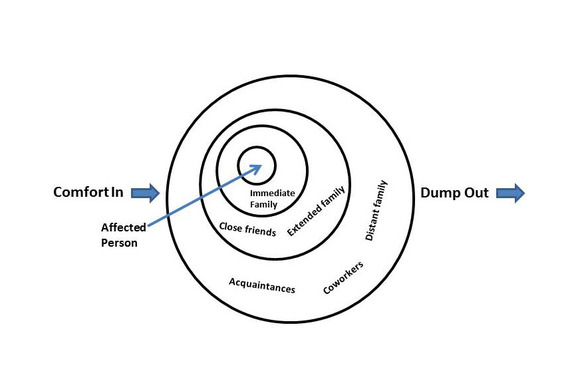Imagine your best friend Mike is seriously injured in a car accident.
When you go visit Mike in the hospital, do you say "I'm so worried about you! This is overwhelming. I'm so scared, Mike!"
No, of course not! You say "I'm so sorry, Mike. I'm praying for you," and you bring him what he needs, spend time with him, try to keep him in good spirits. And you also make sure Mike's family members are okay - comfort them, bring them food, help with the kids - whatever you can do.
Throughout all of this, you're feeling sad, anxious, scared. But you know Mike and his family have it way worse right now. They need your comfort and love, and they don't have any extra energy left over to comfort you. You have to seek comfort somewhere else, so you go home and tell your significant other about your feelings. And they comfort you.
You're following a very logical order: "comfort in, dump out."
We're so good at following this order in real life. We just get it. But on social media, we struggle. We're used to asking for comfort and support there, so we want to keep doing that. It feels natural. But when traumatic things are happening on a large scale, we can't let ourselves forget that they're affecting different people in different ways. We need to take a breath, and try to be a bit more careful.
We need to put Susan Silk's Ring Theory into action.
Silk, a communications expert, created a series of concentric circles to remind us how to take care of each other in traumatic situations:
The person directly experiencing trauma goes in the middle of the circle. To use my earlier example, the person in the middle would be Mike. His family members go in the next circle, and then closest friends and extended family goes in the next circle out. Then more distant friends, family, coworkers and acquaintances.
Once you map out the circles, you can clearly see what Susan calls your "Kvetching Order", or who you get to complain to. The person in the innermost circle can complain to everyone, and they're not expected to give comfort to anyone. They simply receive. Each circle further out gives comfort in towards the circle, and asks for comfort from (and complains to) those in more distant rings.
What This Looks Like on Social Media
There are a lot of "Mikes" among your friends and followers at any given time:
- When immigration is blamed for crime and unemployment, "Mike" is your immigrant friends.
- When an unarmed black man is murdered by police, "Mike" is your black friends.
- When legislation is announced that erodes abortion rights, "Mike" is your women friends.
- When Islamophobia is spread by the media, "Mike" is your Muslim friends.
"Mike's family" is also very present. For example, you may not personally be close to an undocumented person, but there's a big chance that someone you know is. When a discriminatory immigration policy takes effect, their experience of fear, anger, despair, being overwhelmed - whatever it is - is concrete in a way that yours is not.
If we go a level deeper, and think beyond recent crises, what we're really talking about is different levels of privilege. Because if you're white, you know your black friends simply exist closer to the center of the circle than you on a wide range of issues. If you're Christian, you know the same thing about your Muslim friends. If you're a US citizen, you're at a distinct advantage over your immigrant friends. Same goes for women and men, straight/cis people and LGBT people, rich people and poor people, and on and on.
Just being who we are puts us at different places in the circles, and our places come into stark focus at times of severe oppression. Because we all have multiple identities (you can be a gay black immigrant), we're all navigating different circles at once. It's complex.
I'm imagining at this point that some people will say "so you're telling me I can't ever share my feelings on Facebook or Twitter?" No - you can do whatever you want. You're always free to express your feelings. But if you're expressing comfort-seeking feelings to hundreds of people at once, it's impossible to also follow the Ring Theory. It doesn't work.
How You Can Follow the Ring Theory on Social Media
What does "comfort in" look like in times like these? It's a little bit different from comforting your friend in the hospital.
Maybe "comfort in" on social media looks something like this:
- Amplifying the voices of your friends who are directly affected by an issue.
- Showing what you're doing to support, and encouraging others to the do same.
- Saying why you believe an issue is important, and sharing resources to educate your friends.
It doesn't look like this:
- Saying to the people closer to the middle "I don't understand this problem, teach me."
- Saying to the people closer to the middle "Tell me how I can help you. What do you need?"
- Saying to the people closer to the middle "If I were you, I would..."
- Telling the people closer to the middle how to feel, like "don't worry, it'll all be okay"
- Saying things like "we are all immigrants" or another "we are all [group]" statement. Not only are these statements factually untrue - for example, this "nation of immigrants" is also home to native people, and African American people who were brought here by force - but they erase our very real differences in lived experience.
We do need to learn from each other and we especially need to learn how we can support people closer to the middle of the circle. The most effective way for us to learn is by listening. We must remember that "comfort in" means you cannot make demands on anybody closer to the middle of the circle than you. Here's a good rule of thumb:
- Listen to the people closer to the middle of the circle than you.
- Talk to the people further away from the middle of the circle than you.
As Susan Silk says, "if you're going to open your mouth, ask yourself if what you are about to say is likely to provide comfort and support. If it isn't, don't say it."
So next time you have that need for comfort, and you're about to post something like:
- "I'm so overwhelmed" or
- "I'm going to go hide under a blanket"
What can you do? It's very easy: just text or message a friend instead. Or post in a group chat or a "secret group." Control your audience. This is the only way you can be sure you're following your "kvetching order." You'll get the comfort you need to keep on going. And you won't harm anyone closer to the middle of the circle in the process.
How the Ring Theory Conserves our Collective Energy
Everyone's energy is precious when we're engaged in resistance. Many of us who are new to this have spent a lot of time feeling safely out of danger's way, in the outermost rings of the circle. We're so shocked by the new demands on our time and energy, that we forget that not everyone is completely new to this, like us. We need a dose of perspective.
Imagine you live near a river that floods every year, but it usually only damages the houses nearest the riverbank. This year, the water level is rising to unprecedented levels and suddenly your house, a mile away and on higher ground, is in danger. So you put on your work clothes and go out to join the sandbagging effort. For the very first time, you're working alongside the people who do this hard work every year. Do you complain loudly about how tired your arms are, frequently mention how you've never had to do this before, and take a lot of breaks? Or do you keep your head down, work hard, and learn everything you can from the others? Remember, you can always vent later to your friend who lives two miles from the river.
Comfort in, dump out.

